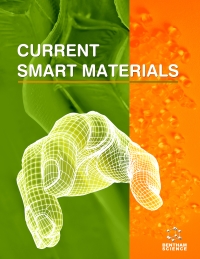- Home
- A-Z Publications
- Current Smart Materials
- Previous Issues
- Volume 5, Issue 2, 2021
Current Smart Materials - Volume 5, Issue 2, 2021
Volume 5, Issue 2, 2021
-
-
A Review of Synthesis and Applications of Boron Nitride Nanotubes (BNNTs) with Future Prospects
More LessAuthors: Mohd Yusuf and Shafat A. KhanEmerging nanotechnology in the early 1990s introduced nanoscaled and advanced materials such as Carbon Nanotubes (CNT) with specific chemical structure and exceptional unique properties. Generally, among the various nanostructures particularly, nanotubes have shown their specific values due to their inherent characteristics. With the time being, new vistas were opened for developing other nanotube-based Read More
-
-
-
A Glance on Rare Earth Oxides: Importance, Reserves, De mand, Applications, Critical Uncertainties, Global Economy, and Zeta Potential Characterization
More LessAuthors: Silas Santos, Orlando Rodrigues and Letícia CamposBackground: Innovation mission in material science requires new approaches to form functional materials, wherein the concept of its formation begins in nano/micro scale. Rare earth oxides with general form (RE2O3; RE from La to Lu, including Sc and Y) exhibit particular proprieties, being used in a vast field of applications with high technological content since agriculture to astronomy. Despite their applicability, there is a la Read More
-
-
-
Growth Process of Cd0.8Zn0.2Te Crystal to Enhance its Performance as Detector for High-energy Radiation
More LessBy Ching-Hua SuIntroduction: In the applications of room temperature detector for high-energy radiation, there are two critical requirements for the semiconducting material cadmium zinc telluride (CdZnTe): (1) high electrical resistivity to reduce the bulk leakage current and (2) low levels of structural defects which hinder the detectivity as trapping and recombination centers for the carriers. To enhance the performance of th Read More
-
-
-
Cholesterol Decorated Pyridinium Urea and Carbamate as π-Gelators for Selective Recognition of F- Ions
More LessAuthors: Santanu Panja and Kumaresh GhoshAim: The design and synthesis of new molecules capable of forming self-assembled gels are indispensable to harvest new functional materials. Supramolecular gels have potential in many areas, particularly in biology and materials chemistry. Of the different types of applications, visual sensing of biologically relevant ionic analytes is a fairly recent trend. Here we describe naked-eye detection of fluoride ions involving sol- Read More
-
-
-
Microstructure Evolution of Yttria Compacts by Powder Technology
More LessAuthors: Silas C. Santos, Orlando Rodrigues Junior and Leticia CamposBackground: Innovation in ceramic materials relies on the processing of powders. Yttria, also known as yttrium oxide, belongs to the rare-earth group (RE2O3 - RE from La to Lu, including Sc and Y). Due to the great properties and end-use of RE-based materials since agriculture until astronomy, studies on processing, sintering and microstructural evolution of RE-based materials are essential to provide new materials Read More
-
-
-
Design of Cellulose Derivative and Alginate Based Smart Polymers to Develop Stomach Specific Floating Drug Delivery System
More LessAuthors: Vikrant Sharma and Jogindera DeviBackground: Polysaccharide based gastro-retentive drug delivery systems (GRDDSs) can retain in the gastric fluid of stomach for a longer time and release the entrapped drug in a controlled and localized manner, which can ensure optimal drug concentration at the site of action with improved bioavailability and reduced side effects of acid-suppressive drugs like ranitidine. Objective: The objective of the present study was to desi Read More
-
-
-
Simulating Ultrasound Piezoelectric Power Transfer in the Near Field and Experimental Validations
More LessAuthors: Ammar Mohammed, Changki Mo, John Miller, David Lowry and Jassim AlhamidBackground: Acoustic power transfer is a method for wireless energy transfer to implanted medical devices that permits a greater range of separation between transmitter and receiver than is possible with inductive power transfer. In some cases, short-distance ultrasonic power transfer may be employed; consequently, their operation may be complicated by the near-field aspects of piezoelectric acoustic energy transfer. Read More
-
Volumes & issues
Most Read This Month
Article
content/journals/csm
Journal
10
5
false
en


